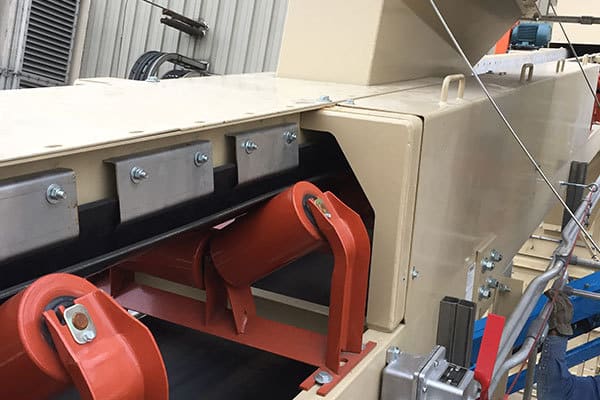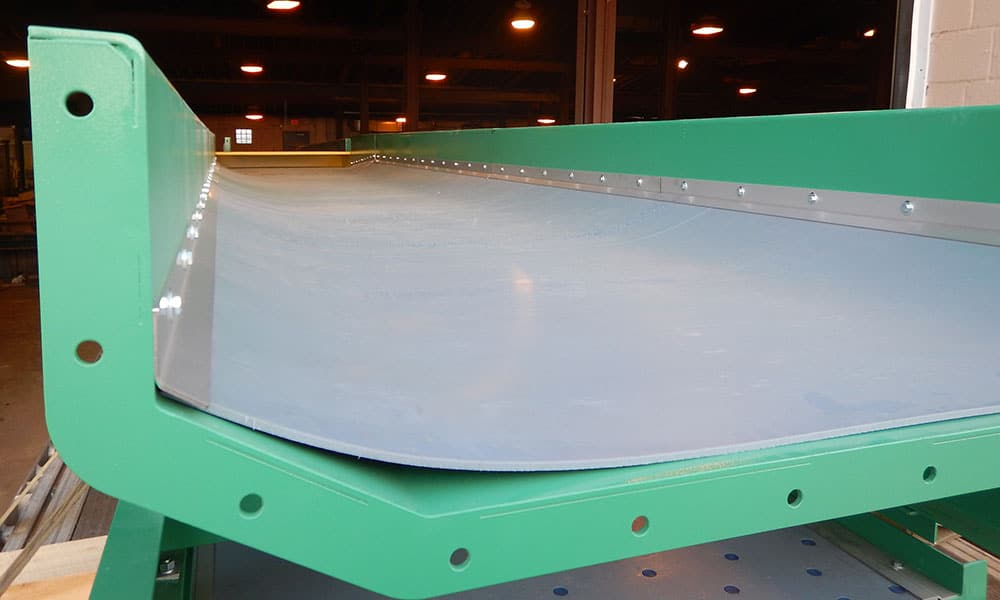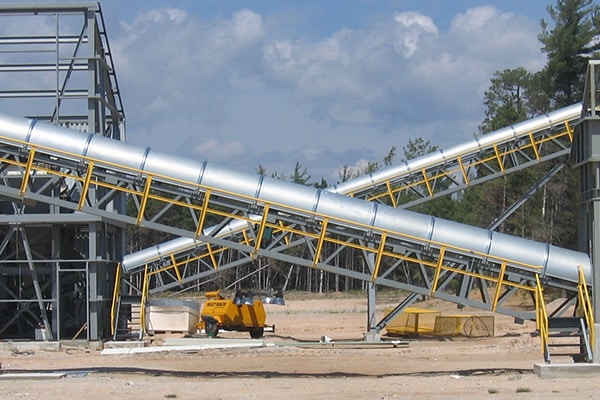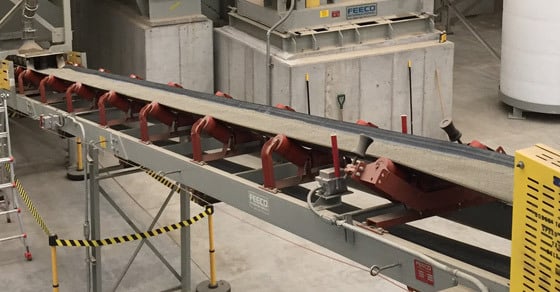A well-designed troughed belt conveyor generally exhibits minimal material spillage. Unfortunately, spillage is an all-too-common problem for many plant managers dealing with troughed belt conveyors that weren’t adequately designed for their application.
Fortunately, there are several ways to address troughed belt conveyor spillage. The following provides an overview on the consequences of material spillage, why it occurs, and how to resolve it.
What is Conveyor Spillage?
Spillage, not to be confused with slippage, refers to any material that falls off of the conveyor belt into the surrounding area, whether that be at the loading zone, along the conveyor length, or at the discharge. Spillage can occur with both inclined and horizontal troughed belt conveyors for various reasons.
No matter what the cause, however, minimizing spillage is a key objective for plant managers and operators, as it causes a number of issues.
Consequences of Material Spillage
The consequences of material spillage are numerous and have the potential to be severe and costly. The issues associated with material spillage from conveyors may vary depending on the setting, but in general, include:
Material Loss
Whether losing raw materials or finished product, even a small amount of lost material quickly contributes to profit losses and inflated operating costs. This may come in the form of spoiled or inferior product, reprocessing costs, or lost feedstock. As one can imagine, this is especially problematic when handling high-value materials or products.
Safety Concerns
In many cases, fugitive material can be a safety hazard. This may be because the material poses a toxicity or inhalation risk, creates tripping or slipping hazards for employees, or causes equipment to malfunction.
Increased Downtime
Not surprisingly, material spillage frequently drives up downtime and labor costs. Time and labor are often lost, whether that’s due to stopping the entire operation for a clean-out, managing fugitive material in the plant, addressing equipment issues caused by fugitive material, or otherwise.
Reduced Equipment Life
Material spillage also frequently causes equipment degradation, especially if not carefully managed. Fugitive material has the potential to damage conveyor belts, idlers, and drive components, all costly parts to replace.
Damage may occur as a result of the material’s specific characteristics, such as its corrosiveness, or because material has been allowed to build up and cause interference between components.
Why Spillage Occurs With a Troughed Belt Conveyor
There are a number of potential causes for spillage, but they can usually all be traced back to the equipment’s original design.
The uniqueness of characteristics across materials and at different points in the handling process, coupled with the specificity of facility infrastructure, necessitates that conveyors be designed around the particular demands of their intended application. Less costly one-size-fits-all solutions can be tempting, but almost always incur greater costs in the long run.
The root cause of spillage in any given bulk material handling system, if not overtly obvious, is best determined by a bulk solids handling expert. Common causes of spillage include:
- An improperly tensioned belt
- Lack of a belt cleaner system
- Inadequate sealing at loading points
- Improper or uneven feeding to belt
- Erratically running belt
- Running a conveyor beyond its rated capacity
How to Minimize Material Spillage With Troughed Belt Conveyors
The following are common ways to help minimize conveyor spillage. However, addressing conveyor spillage should begin with identifying the root cause of the issue, as this will dictate the best approach to resolve spillage. The FEECO Customer Service Team offers process and equipment audits to assess bulk material handling systems for mechanical problems, design issues, and general optimization.
Material Spillage at Loading Area
Material spillage is more likely to occur at loading zones than along the length of the conveyor. Common ways to address spillage at loading areas include:
Add Skirtboards
Skirtboards help to minimize material by keeping it contained at the sides of the conveyor. In other words, skirtboards provide a place for material to ride against, as opposed to falling off the sides of the conveyor. Some conveyors experiencing problems may already have existing skirtboards, but they are not properly designed. For example, idlers may be spaced too far apart. In some cases, existing skirtboard rubber may be worn, requiring replacement or adjustment.

FEECO Conveyor with skirtboard at loading area
Add an Apron Seal
An apron seal can be added to skirtboards as a way to further prevent fugitive material from escaping at the loading area. Integrated exhaust ports can also be added at the skirtboard area for dust pick-off at loading.
Add Slider Bed or Decrease Idler Spacing
To further minimize spillage, idlers can be replaced by a slider bed at the loading area which will eliminate any belt sag between idlers.

FEECO Slider Bed for reducing material spillage at conveyor loading zone
Spillage at the loading area can also be the result of a sagging belt, which creates gaps from which material can escape between the belt and skirtboard rubber. This can be resolved by decreasing the space between idlers at the loading area until any sagging is mitigated. Typical spacing is one foot at load zone and two feet for the remainder of skirtboards. This helps to create a better seal between the belt and skirtboards.
Ensure Proper Feeding
Various feeding issues can exist that are likely to result in material spillage upon loading. Common feed issues include uneven loading (loading should be centered, not skewed to one side), a worn hopper (i.e., holes in the hopper or feeder allow material to escape), inconsistent material flow or ratholing in the hopper, a feed rate that is too high, or a mismatch between feed rate and belt speed. All of these issues have the potential to overload the conveyor, either consistently, or intermittently. These issues must be specifically addressed, either through adjustments in the feedstock, modifications to or implementation of a new hopper, adjustment of feed rate or belt speed, or otherwise.
Spillage is especially likely when working with stringy materials such as wood chips or bark, as these do not flow and feed as cleanly as other materials. These types of materials often require special consideration when designing the conveyor load zone.
Material Spillage Along the Length of the Conveyor
While material spillage is most common at loading zones, it can be an issue along the length of the conveyor if something is wrong. The cause, and ultimate resolution for spillage along the length of the conveyor is usually fairly obvious. Common ways to minimize spillage along the conveyor length include:
Increase or Decrease Belt Tension
A belt tension that is too high pulls and stretches the conveyor belt, preventing it from troughing properly and therefore making it unable to contain material as well. If belt tension is too low, the belt will sag between idlers, allowing material to fall off the sides. These issues are resolved by properly tensioning the belt.
Reduce Belt Load
Overloaded belt conveyors also cause spillage. CEMA, the authority on conveyor standards, recommends belt loading not exceed 75%, so operations consistently running beyond this should consider a means of either reducing belt load, or increasing available handling capacity through additional or replacement handling equipment.
Increase Angle of Idlers/ Trough Depth
Idlers can be adjusted to accommodate a variety of trough angles, typically 20°, 35°, and 45°. If the trough is too shallow, material may spill over the edges. By adjusting the idler angles to form a deeper trough, material can be better contained.
Remove Buildup
Excessive buildup is not only damaging to the belt and idlers, but it can also interfere with how the belt runs. Material that is allowed to build up on idlers, or at other points along the conveyor can cake, harden, and/or cause interference, causing the belt to run unevenly or erratically, spilling the material. By removing buildup, the interference is mitigated, though additional repairs may be necessary. Conveyors should be routinely cleaned when there is potential for buildup to occur.
Keep Belt Dry
In some cases, a wet belt could be the cause for spillage, as it can promote sticking or slipping of the material on the belt. This is often seen with unprotected belt conveyors operating outdoors, as they are subject to rain and frost, which can cause the belt to become slippery. Conveyors operating outdoors should utilize weather covers or gallery enclosures to protect the material and the belt. If the belt is operating indoors, identify the source of moisture and work to resolve it.

Outdoor FEECO Troughed Belt Conveyors with weather covers
Add a Belt Cleaner
Belt cleaners are installed at the head pulley to remove any material that may be stuck to the belt after discharge. Material on the return side of the belt will often fall off along the length of the conveyor, clogging up idlers and creating a housekeeping issue. FEECO recommends belt cleaners on all conveyors as a preventative measure in reducing spillage and potential buildup.
Add Deck Plates & Drip Pans
Deck plates and drip pans serve to catch falling material, and while they do not prevent spillage or address the root cause, they can help to keep spillage contained.
Conclusion
While material spillage is typically not an issue on well-designed troughed belt conveyors, it can be a problem when conveyors are not suited to their duty, or when problems arise. These issues have the potential to be costly in the form of lost or inferior material, liability risks, and additional maintenance and cleaning, as well as increased downtime. Fortunately, there are many ways to minimize material spillage, both at the loading zone, and along the length of the conveyor.
FEECO provides bulk material handling equipment and systems to a variety of industries, from mining and minerals to fertilizers and chemicals. All FEECO conveyors are engineered around the application’s unique requirements for a seamless handling system with minimal spillage. Contact us today to learn more about our custom belt conveyors, process and equipment audits, and minimizing material spillage.



